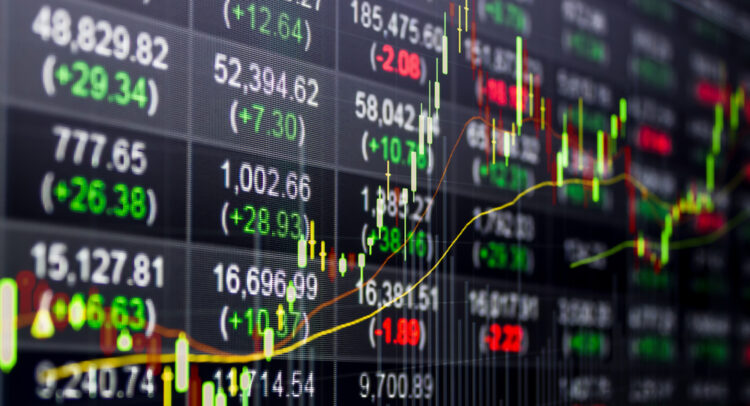Last Updated 4:05 PM EST
Don't Miss our Black Friday Offers:
- Discover the latest stocks recommended by top Wall Street analysts, all in one place with Analyst Top Stocks
- Make smarter investments with weekly expert stock picks from the Smart Investor Newsletter
Stock indices finished today’s trading session mostly in the green. The Nasdaq 100 (NDX), S&P 500 (SPX), and the Dow Jones Industrial Average (DJIA) gained 0.06%, 0.24%, and 0.63%, respectively. The utilities sector (XLU) was the session’s laggard, as it lost 0.41%. Conversely, the industrial sector (XLI) was the session’s leader, with a gain of 1.41%.
Furthermore, the U.S. 10-Year Treasury yield decreased to 4.01%, a decline of more than six basis points. Similarly, the Two-Year Treasury yield also decreased, as it hovers around 4.87%.
The Atlanta Federal Reserve updated its latest GDPNow reading, which allows it to estimate GDP growth in real-time. The “nowcast” becomes more accurate as more economic data is released throughout the quarter. Currently, it estimates that the economy will expand by about 2.3% in the second quarter.
This is higher than its previous estimate of 2.1%, which can be attributed to recent releases from the U.S. Bureau of Economic Analysis, the U.S. Bureau of Labor Statistics, and the U.S. Census Bureau.
Last updated: 12:00 PM EST
Stock indices are mixed so far in today’s trading session as U.S. inflation remains stubbornly above the Federal Reserve’s target of 2%, prompting calls for further interest-rate increases from Cleveland Fed President Loretta Mester. She pointed to the economy’s surprising resilience and stressed the need for the funds rate to rise and hold steady to ensure sustainable inflation.
Balancing demand and supply has been sluggish, and the present inflation pressure must be tackled for a smooth return to 2% inflation. A key challenge lies in the tight labor market and the containment of sticky wage growth, despite some of the most aggressive rate-hiking cycles in recent history.
Echoing similar sentiments, San Francisco Fed President Mary Daly also hinted at the need for a couple more rate hikes by year-end to moderate the surprisingly strong economy. However, she underlined the growing risks from banking stresses and the narrowing gap between the risks of doing too little and too much. She advocated for a balance between careful bank supervision and efficiency in response to recent bank failures and Silicon Valley Bank’s collapse.
This idea was further expanded upon by Federal Reserve Vice Chair for Supervision Michael Barr, who presented a series of proposals to reinforce the financial system, including stronger capital requirements for large banks and modifications in regulations to improve the speed and effectiveness of the Federal Reserve’s supervision.
Last updated: 9:30 AM EST
The earnings season kicks off in high gear, while the inflation print will be out later this week. Stock markets opened higher at the start of this week, with the Nasdaq 100 (NDX), S&P 500 (SPX), and the Dow Jones Industrial Average (DJIA) up 0.03%, 0.12%, and 0.3%, respectively, at 9:30 a.m., EST, July 10.
First published: 4:43AM EST
U.S. Futures are down on Monday morning as traders eagerly await the consumer price index (CPI) data and the beginning of the second quarter earnings season this week. Futures on the Nasdaq 100 (NDX), S&P 500 (SPX), and the Dow Jones Industrial Average (DJIA) are down 0.44%, 0.35%, and 0.25%, respectively, at 4:00 a.m., EST, July 10.
The three major averages finished the last trading week on a negative footing, owing to the stronger-than-expected ADP employment report. Nevertheless, the U.S. labor market created fewer-than-expected new jobs in June, and the unemployment rate slid to 3.6% from 3.7% in May. Notably, the key inflation report is due on Wednesday, with experts projecting a 3.1% increase in the CPI reading for the twelve months ending June 30, lower than the 4% annual rise in May. Meanwhile, the producer price index (PPI) report is due the next day, July 13. Even though inflation has shown signs of cooling, it’s far from the Fed’s targeted 2% rate. The strong labor market suggests that the Fed could raise interest rates at this month’s FOMC meeting.
Turning to the earnings season, the major banks will kick off earnings on Friday, July 14. These include JPMorgan Chase & Co. (JPM), BlackRock (BLK), Citigroup (C), State Street (STT), and Wells Fargo (WFC). Similarly, non-financial companies, including PepsiCo (PEP), Delta Airlines (DAL), and Conagra Brands (CAG) will report on July 13. Wall Street is expecting muted earnings reports for the June quarter as the full effects of March’s banking crisis will be reflected in Q2. Plus, the recent AI buzz has lifted the companies’ stock prices and investor expectations in the tech sector, which may not reflect fully in the financial performances for the quarter.
Elsewhere, European indices are trading in the green this morning, reacting to China’s lower-than-expected PPI reading today. Global markets also await the U.S. CPI and PPI prints this week.
Asia-Pacific Markets End Mixed on Monday
Asia-Pacific indices ended mixed on Monday, influenced by China’s cooling inflation data, which adds to the possibility of a disinflationary environment. The mainland’s CPI data remained flat for the twelve months ending June, compared to last year. Plus, the PPI data fell rapidly by 5.4% on an annual basis, higher than the expected 5% decline. Meanwhile, Treasury Secretary Janet Yellen concluded her four-day trip to Beijing on a positive note calling it “direct, substantive, and productive.”
Hong Kong’s Hang Seng and China’s Shanghai Composite and Shenzhen Component indexes ended higher by 0.62%, 0.22%, and 0.50%, respectively.
On the other hand, Japan’s Nikkei and Topix indices finished down by 0.61% and 0.51%, respectively.
Interested in more economic insights? Tune in to our LIVE webinar.



















